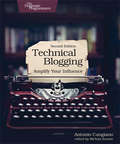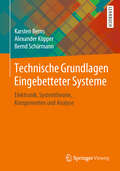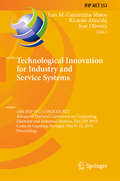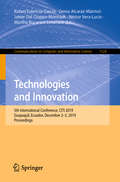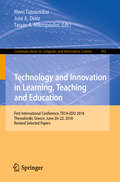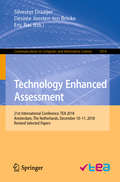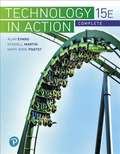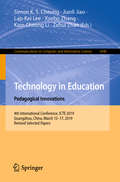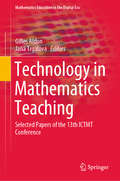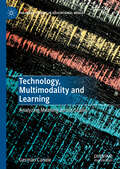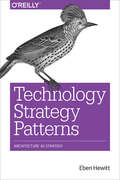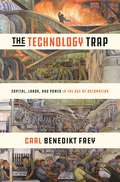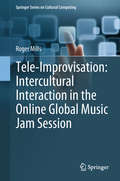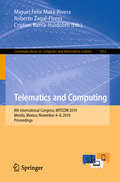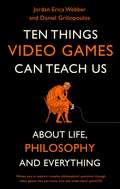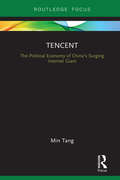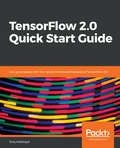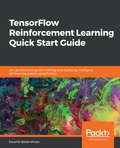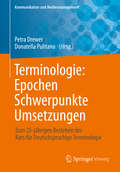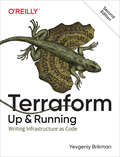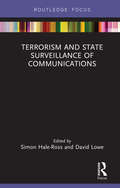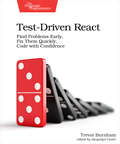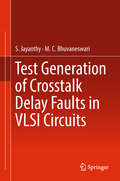- Table View
- List View
Technical Blogging: Amplify Your Influence
by Antonio CangianoSuccessful technical blogging is not easy but it's also not magic. Use these techniques to attract and keep an audience of loyal, regular readers. Leverage this popularity to reach your goals and amplify your influence in your field. Get more more users for your startup or open source project, or simply find an outlet to share your expertise. This book is your blueprint, with step-by-step instructions that leave no stone unturned. Plan, create, maintain, and promote a successful blog that will have remarkable effects on your career or business. Successful people often get recognition by teaching what they know. Blogging is a reliable path to do that, while gaining influence in the process. The problem is getting it right. Far too often professionals start a blog with big hopes, only to quickly give up because they don't get speedy results. This book will spare you that fate, by outlining a careful plan of action. A plan that will bring amazing benefits to your career, new job possibilities, as well as publishing, speaking, and consulting opportunities. And if you are blogging for business, you'll attract new customers, partners, and outstanding employees. Understand what blogging is and how it can improve your professional (and personal) life. Devise a plan for your new or existing blog. Create remarkable content that ranks well in Google and is shared by readers. Beat procrastination by employing proven time-management techniques that make you an efficient and effective blogger. Promote your blog by mastering on-page and off-page SEO, as well as social media promotion, without compromising your ethics. Analyze your traffic to understand your audience and measure growth. Build a community around your blog and make the best of your newfound popularity, by maximizing its benefits for your career, business, or simply for extra income. Create and maintain a successful technical blog that will amplify your impact, influence, and reach by following Antonio's step-by-step plan.
Technische Grundlagen Eingebetteter Systeme: Elektronik, Systemtheorie, Komponenten und Analyse
by Karsten Berns Alexander Köpper Bernd SchürmannLernen Sie mit diesem Lehrbuch eingebettete Systeme besser kennenEmbedded Systems (eingebettete Systeme) sind aus dem Alltag nicht mehr wegzudenken. In Smartphones, Fahrzeugen oder Haushaltsgeräten verbinden sie die analoge mit der digitalen Welt. Daraus ergeben sich speziell für Entwickler eingebetteter Systeme viele Anforderungen. Sie müssen nicht nur Kenntnisse aus der Entwicklung von Softwaresystemen mitbringen, sondern gleichzeitig Wissen in Sachen Elektrotechnik oder Systemkomponenten besitzen. Dieses Lehrbuch führt Sie umfassend in das Feld eingebetteter Systeme ein. Die Autoren liefern Ihnen das notwendige methodische sowie systematische Wissen zur Systementwicklung. Zum optimalen Verständnis ist dieses Werk in vier Teile untergliedert:Technische Grundlagen eingebetteter Systeme aus den Gebieten Elektronik, Systemtheorie, Steuerung und Regelung Systemtheoretische Grundlagen und Entwürfe von ReglernÜberblick und Einbindung der Systemkomponenten eingebetteter SystemeModellierung und Analyse von Algorithmen mit Blick auf EchtzeitanforderungenDurch Anwendungsbeispiele und Methoden der Echtzeitplanung können Sie mit diesem Lehrbuch Ihr Wissen im Bereich eingebettete Systeme nachhaltig vertiefen. Inhaltlich für Praktiker und Theoretiker zu empfehlenAufgrund seines thematischen Schwerpunkts profitieren von diesem Werk speziell folgende Leser:a) Studierende und Anwender der Informatik ohne tiefgreifende Vorkenntnisse im Bereich Elektrotechnikb) Ingenieure, Physiker und Mathematiker, die sich für die Grundlagen der Entwicklung eingebetteter Systeme interessierenIn den einführenden Kapiteln des Lehrbuchs definieren die Autoren zunächst die Merkmale eingebetteter Systeme. Sie zeigen Ihnen Anwendungsfelder und erläutern, in welcher Form diese Systeme zum Einsatz kommen – beispielsweise als Cyber-Physikalische Systeme (CPS). Im weiteren Verlauf werden u. a. diese Teilaspekte näher behandelt:Elektrische NetzwerkeElektronische GrundschaltungenSignalverarbeitungsprozesseSensordatenverarbeitungAktuatorikRecheneinheiten für eingebettete SystemeKommunikationEin Grundlagenwerk mit verständlichem KonzeptDurch seinen systematischen Aufbau ermöglicht Ihnen dieses Werk einen schnellen Einstieg in die Materie. Anschauliche Tabellen, Grafiken, Anwendungsbeispiele sowie Modelle unterstützen Sie beim Lernprozess. Wenn Sie sich für eingebettete Systeme interessieren, darf dieses Lehrbuch in Ihrer Sammlung nicht fehlen.
Technological Innovation for Industry and Service Systems: 10th IFIP WG 5.5/SOCOLNET Advanced Doctoral Conference on Computing, Electrical and Industrial Systems, DoCEIS 2019, Costa de Caparica, Portugal, May 8–10, 2019, Proceedings (IFIP Advances in Information and Communication Technology #553)
by Luis M. Camarinha-Matos Ricardo Almeida José OliveiraThis book constitutes the refereed proceedings of the 10th IFIP WG 5.5/SOCOLNET Advanced Doctoral Conference on Computing, Electrical and Industrial Systems, DoCEIS 2019, held in Costa de Caparica, Portugal, in May 2019. The 36 revised full papers presented were carefully reviewed and selected from 73 submissions. The papers present selected results produced in engineering doctoral programs and focus on technological innovation for industry and serivce systems. Research results and ongoing work are presented, illustrated and discussed in the following areas: collaborative systems, collaboration and resilient systems, decision and optimization systems, assistive systems, smart environments, smart manufacturing, water monitoring systems, communication systems, and energy systems.
Technologies and Innovation: 5th International Conference, CITI 2019, Guayaquil, Ecuador, December 2–5, 2019, Proceedings (Communications in Computer and Information Science #1124)
by Rafael Valencia-García Gema Alcaraz-Mármol Néstor Vera-Lucio Martha Bucaram-Leverone Javier Del Cioppo-MorstadtThis book constitutes the proceedings of the 5th International Conference on Technologies and Innovation, CITI 2019, held in Guayaquil, Ecuador, in December 2019. The 14 full papers presented in this volume were carefully reviewed and selected from 32 submissions. They are organized in topical sections named: ICT in agronomy; knowledge-based systems and pattern recognition; internet of things and computer architecture.
Technology and Innovation in Learning, Teaching and Education: First International Conference, TECH-EDU 2018, Thessaloniki, Greece, June 20–22, 2018, Revised Selected Papers (Communications in Computer and Information Science #993)
by Meni Tsitouridou José A. Diniz Tassos A. MikropoulosThis book constitutes the thoroughly refereed post-conference proceedings of the First International Conference on Technology and Innovation in Learning, Teaching and Education, TECH-EDU 2018, held in Thessaloniki, Greece, on June 20-22, 2018. The 30 revised full papers along with 18 short papers presented were carefully reviewed and selected from 80 submissions.The papers are organized in topical sections on new technologies and teaching approaches to promote the strategies of self and co-regulation learning (new-TECH to SCRL); eLearning 2.0: trends, challenges and innovative perspectives; building critical thinking in higher education: meeting the challenge; digital tools in S and T learning; exploratory potentialities of emerging technologies in education; learning technologies; digital technologies and instructional design; big data in education and learning analytics.
Technology Enhanced Assessment: 21st International Conference, TEA 2018, Amsterdam, The Netherlands, December 10–11, 2018, Revised Selected Papers (Communications in Computer and Information Science #1014)
by Silvester Draaijer Desirée Joosten-ten Brinke Eric RasThis book constitutes the proceedings of the 21st International Conference on Technology Enhanced Assessment, TEA 2018, held in Amsterdam, The Netherlands, in December 2018. The 14 papers presented were carefully selected from 34 submissions. They are centered around topics like e-learning, computer-assisted instruction, interactive learning environments, collaborative learning, computing education, student assessment.
Technology in Action
by Alan Evans Kendall Martin Mary Anne PoatsyAuthors know how readers learn today and help them focus on tasks that they can apply immediately in the workplace, the classroom, and at home. <P><P>The 15th Edition uses practical content, hands-on projects, and coverage of artificial intelligence to provide an engaging learning experience. This in turn helps learners be more prepared, and provides them with the skills they need to be digitally literate in their everyday lives and in the workplace.
Technology in Education: 4th International Conference, ICTE 2019, Guangzhou, China, March 15-17, 2019, Revised Selected Papers (Communications in Computer and Information Science #1048)
by Simon K. S. Cheung Jianli Jiao Lap-Kei Lee Xuebo Zhang Kam Cheong Li Zehui ZhanThis book constitutes extended papers from the 4th International Conference on Technology in Education, ICTE 2019, held in Guangzhou, China, in March 2019.The 27 full papers presented in this volume were carefully reviewed and selected from 109 submissions. They are organized in topical sections on blended bearning and computer-supported learning; virtual reality, augmented reality and game-based learning; open online courses and open educational resources; teaching and learning analysis and assessment; pedagogical, psychological and cultural issues.
Technology in Mathematics Teaching: Selected Papers of the 13th ICTMT Conference (Mathematics Education in the Digital Era #13)
by Gilles Aldon Jana TrgalováThis book comprises chapters featuring a state of the art of research on digital technology in mathematics education. The chapters are extended versions of a selection of papers from the Proceedings of the 13th International Conference on Technology in Mathematics Teaching (ICTMT-13), which was held in Lyon, France, from July 3rd to 6th. ICTMT-13 gathered together over one hundred participants from twenty countries sharing research and empirical results on the topical issues of technology and its potential to improve mathematics teaching and learning. The chapters are organised into 4 themed parts, namely assessment in mathematics education and technology, which was the main focus of the conference, innovative technology and approaches to mathematics education, teacher education and professional development toward the technology use, and mathematics teaching and learning experiences with technology. In 13 chapters contained in the book, prominent mathematics educators from all over the world present the most recent theoretical and practical advances on these themes This book is of particular interest to researchers, teachers, teacher educators and other actors interested in digital technology in mathematics education.
Technology, Multimodality and Learning: Analyzing Meaning across Scales (Palgrave Studies in Educational Media)
by Germán CanaleThis book introduces multimodality and technology as key concepts for understanding learning in the 21st century. The author investigates how a nationwide socio-educational policy in Uruguay becomes recontextualised across time/space scales, impacting interaction and learning in an English as a Foreign Language classroom. The book introduces scalar analysis to better understand the situated and fractal nature of education policy as meaning-making, subsequently defining learning from a multimodal socio-semiotic approach. The analytical integration of different policy scales shows what policy means to various stakeholders, and what learning means for students and teachers. This depends both on how they position themselves and how they engage with the policy educational media. This innovative book will appeal to students and scholars of technology and learning, as well as multimodality.
Technology Strategy Patterns: Architecture as Strategy
by Eben HewittTechnologists who want their ideas heard, understood, and funded are often told to speak the language of business—without really knowing what that is. This book’s toolkit provides architects, product managers, technology managers, and executives with a shared language—in the form of repeatable, practical patterns and templates—to produce great technology strategies.Author Eben Hewitt developed 39 patterns over the course of a decade in his work as CTO, CIO, and chief architect for several global tech companies. With these proven tools, you can define, create, elaborate, refine, and communicate your architecture goals, plans, and approach in a way that executives can readily understand, approve, and execute.This book covers:Architecture and strategy: Adopt a strategic architectural mindset to make a meaningful material impactCreating your strategy: Define the components of your technology strategy using proven patternsCommunicating the strategy: Convey your technology strategy in a compelling way to a variety of audiencesBringing it all together: Employ patterns individually or in clusters for specific problems; use the complete framework for a comprehensive strategy
The Technology Trap: Capital, Labor, and Power in the Age of Automation
by Carl Benedikt FreyHow the history of technological revolutions can help us better understand economic and political polarization in the age of automation From the Industrial Revolution to the age of artificial intelligence, The Technology Trap takes a sweeping look at the history of technological progress and how it has radically shifted the distribution of economic and political power among society’s members. As Carl Benedikt Frey shows, the Industrial Revolution created unprecedented wealth and prosperity over the long run, but the immediate consequences of mechanization were devastating for large swaths of the population. Middle-income jobs withered, wages stagnated, the labor share of income fell, profits surged, and economic inequality skyrocketed. These trends, Frey documents, broadly mirror those in our current age of automation, which began with the Computer Revolution.Just as the Industrial Revolution eventually brought about extraordinary benefits for society, artificial intelligence systems have the potential to do the same. But Frey argues that this depends on how the short term is managed. In the nineteenth century, workers violently expressed their concerns over machines taking their jobs. The Luddite uprisings joined a long wave of machinery riots that swept across Europe and China. Today’s despairing middle class has not resorted to physical force, but their frustration has led to rising populism and the increasing fragmentation of society. As middle-class jobs continue to come under pressure, there’s no assurance that positive attitudes to technology will persist.The Industrial Revolution was a defining moment in history, but few grasped its enormous consequences at the time. The Technology Trap demonstrates that in the midst of another technological revolution, the lessons of the past can help us to more effectively face the present.
Tele-Improvisation: Intercultural Interaction in the Online Global Music Jam Session (Springer Series on Cultural Computing)
by Roger MillsThis research monograph explores the rapidly expanding field of networked music making and the ways in which musicians of different cultures improvise together online. It draws on extensive research to uncover the creative and cognitive approaches that geographically dispersed musicians develop to interact in displaced tele-improvisatory collaboration. It presents a multimodal analysis of three tele-improvisatory performances that examine how cross-cultural musician’s express and perceive intentionality in these interactions, as well as their experiences of distributed agency and tele-presence.Tele-Improvisation: Intercultural Interaction in the Online Global Music Jam Session will provide essential reading for musician’s, postgraduate students, researchers and educators, working in the areas of telematic performance, musicology, music cognition, intercultural communication, distance collaboration and learning, digital humanities, Computer Supported Cooperative Work and HCI.
Telematics and Computing: 8th International Congress, WITCOM 2019, Merida, Mexico, November 4–8, 2019, Proceedings (Communications in Computer and Information Science #1053)
by Miguel Felix Mata-Rivera Roberto Zagal-Flores Cristian Barría-HuidobroThis book constitutes the thoroughly refereed proceedings of the 8th International Congress on Telematics and Computing, WITCOM 2019, held in Merida, Mexico, in November 2019. The 31 full papers presented in this volume were carefully reviewed and selected from 78 submissions. The papers are organized in topical sections: GIS & climate change; telematics & electronics; artificial intelligence & machine learning; software engineering & education; internet of things; and informatics security.
Ten Things Video Games Can Teach Us: (about life, philosophy and everything)
by Jordan Erica Webber Daniel GriliopoulosWOULD YOU KILL ONE PERSON TO SAVE FIVE OTHERS?If you could upload all of your memories into a machine, would that machine be you? Is it possible we're all already artificial intelligences, living inside a simulation?These sound like questions from a philosophy class, but in fact they're from modern, popular video games. Philosophical discussion often uses thought experiments to consider ideas that we can't test in real life, and media like books, films, and games can make these thought experiments far more accessible to a non-academic audience. Thanks to their interactive nature, video games can be especially effective ways to explore these ideas.Each chapter of this book introduces a philosophical topic through discussion of relevant video games, with interviews with game creators and expert philosophers. In ten chapters, this book demonstrates how video games can help us to consider the following questions:1. Why do video games make for good thought experiments? (From the ethical dilemmas of the Mass Effect series to 'philosophy games'.)2. What can we actually know? (From why Phoenix Wright is right for the wrong reasons to whether No Man's Sky is a lie.)3. Is virtual reality a kind of reality? (On whether VR headsets like the Oculus Rift, PlayStation VR, and HTC Vive deal in mass-market hallucination.)4. What constitutes a mind? (From the souls of Beyond: Two Souls to the synths of Fallout 4.)5. What can you lose before you're no longer yourself? (Identity crises in the likes of The Swapper and BioShock Infinite.)6. Does it mean anything to say we have choice? (Determinism and free will in Bioshock, Portal 2 and Deus Ex.)7. What does it mean to be a good or dutiful person? (Virtue ethics in the Ultima series and duty ethics in Planescape: Torment.)8. Is there anything better in life than to be happy? (Utilitarianism in Bioshock 2 and Harvest Moon.)10. How should we be governed, for whom and by who? (Government and rights in Eve Online, Crusader Kings, Democracy 3 and Fable 3.)11. Is it ever right to take another life? And how do we cope with our own death? (The Harm Thesis and the good death in To The Moon and Lost Odyssey.)
Ten Things Video Games Can Teach Us: (about life, philosophy and everything)
by Jordan Erica Webber Daniel GriliopoulosWOULD YOU KILL ONE PERSON TO SAVE FIVE OTHERS?If you could upload all of your memories into a machine, would that machine be you? Is it possible we're all already artificial intelligences, living inside a simulation?These sound like questions from a philosophy class, but in fact they're from modern, popular video games. Philosophical discussion often uses thought experiments to consider ideas that we can't test in real life, and media like books, films, and games can make these thought experiments far more accessible to a non-academic audience. Thanks to their interactive nature, video games can be especially effective ways to explore these ideas.Each chapter of this book introduces a philosophical topic through discussion of relevant video games, with interviews with game creators and expert philosophers. In ten chapters, this book demonstrates how video games can help us to consider the following questions:1. Why do video games make for good thought experiments? (From the ethical dilemmas of the Mass Effect series to 'philosophy games'.)2. What can we actually know? (From why Phoenix Wright is right for the wrong reasons to whether No Man's Sky is a lie.)3. Is virtual reality a kind of reality? (On whether VR headsets like the Oculus Rift, PlayStation VR, and HTC Vive deal in mass-market hallucination.)4. What constitutes a mind? (From the souls of Beyond: Two Souls to the synths of Fallout 4.)5. What can you lose before you're no longer yourself? (Identity crises in the likes of The Swapper and BioShock Infinite.)6. Does it mean anything to say we have choice? (Determinism and free will in Bioshock, Portal 2 and Deus Ex.)7. What does it mean to be a good or dutiful person? (Virtue ethics in the Ultima series and duty ethics in Planescape: Torment.)8. Is there anything better in life than to be happy? (Utilitarianism in Bioshock 2 and Harvest Moon.)10. How should we be governed, for whom and by who? (Government and rights in Eve Online, Crusader Kings, Democracy 3 and Fable 3.)11. Is it ever right to take another life? And how do we cope with our own death? (The Harm Thesis and the good death in To The Moon and Lost Odyssey.)
Tencent: The Political Economy of China’s Surging Internet Giant (Global Media Giants)
by Min TangIn this book, author Min Tang examines the political economy of the China-based leading global Internet giant, Tencent. Tracing the historical context and shaping forces, the book illuminates Tencent’s emergence as a joint creation of the Chinese state and transnational financial capital. Tencent reveals interweaving axes of power on different levels, particularly interactions between the global digital industry and contemporary China. The expansion strategies Tencent has employed—horizontal and vertical integration, diversification and transnationalization—speak to the intrinsic trends of capitalist reproduction and the consistent features of the political economy of communications. The book also pinpoints two emerging and entangling trends— transnationalization and financialization—as unfolding trajectories of the global political economy. Understanding Tencent’s dynamics of growth helps to clarify the complex nature of China’s contemporary transformation and the multifaceted characteristics of its increasingly globalized Internet industry. This short and highly topical research volume is perfect for students and scholars of of global media, political economy, and Chinese business, media and communication, and society.
TensorFlow 2.0 Quick Start Guide: Get up to speed with the newly introduced features of TensorFlow 2.0
by Tony HoldroydPerform supervised and unsupervised machine learning and learn advanced techniques such as training neural networks. Key Features Train your own models for effective prediction, using high-level Keras API Perform supervised and unsupervised machine learning and learn advanced techniques such as training neural networks Get acquainted with some new practices introduced in TensorFlow 2.0 Alpha Book Description TensorFlow is one of the most popular machine learning frameworks in Python. With this book, you will improve your knowledge of some of the latest TensorFlow features and will be able to perform supervised and unsupervised machine learning and also train neural networks. After giving you an overview of what's new in TensorFlow 2.0 Alpha, the book moves on to setting up your machine learning environment using the TensorFlow library. You will perform popular supervised machine learning tasks using techniques such as linear regression, logistic regression, and clustering. You will get familiar with unsupervised learning for autoencoder applications. The book will also show you how to train effective neural networks using straightforward examples in a variety of different domains. By the end of the book, you will have been exposed to a large variety of machine learning and neural network TensorFlow techniques. What you will learn Use tf.Keras for fast prototyping, building, and training deep learning neural network models Easily convert your TensorFlow 1.12 applications to TensorFlow 2.0-compatible files Use TensorFlow to tackle traditional supervised and unsupervised machine learning applications Understand image recognition techniques using TensorFlow Perform neural style transfer for image hybridization using a neural network Code a recurrent neural network in TensorFlow to perform text-style generation Who this book is for Data scientists, machine learning developers, and deep learning enthusiasts looking to quickly get started with TensorFlow 2 will find this book useful. Some Python programming experience with version 3.6 or later, along with a familiarity with Jupyter notebooks will be an added advantage. Exposure to machine learning and neural network techniques would also be helpful.
TensorFlow Reinforcement Learning Quick Start Guide: Get up and running with training and deploying intelligent, self-learning agents using Python
by Kaushik BalakrishnanLeverage the power of Tensorflow to Create powerful software agents that can self-learn to perform real-world tasks Key Features Explore efficient Reinforcement Learning algorithms and code them using TensorFlow and Python Train Reinforcement Learning agents for problems, ranging from computer games to autonomous driving. Formulate and devise selective algorithms and techniques in your applications in no time. Book Description Advances in reinforcement learning algorithms have made it possible to use them for optimal control in several different industrial applications. With this book, you will apply Reinforcement Learning to a range of problems, from computer games to autonomous driving. The book starts by introducing you to essential Reinforcement Learning concepts such as agents, environments, rewards, and advantage functions. You will also master the distinctions between on-policy and off-policy algorithms, as well as model-free and model-based algorithms. You will also learn about several Reinforcement Learning algorithms, such as SARSA, Deep Q-Networks (DQN), Deep Deterministic Policy Gradients (DDPG), Asynchronous Advantage Actor-Critic (A3C), Trust Region Policy Optimization (TRPO), and Proximal Policy Optimization (PPO). The book will also show you how to code these algorithms in TensorFlow and Python and apply them to solve computer games from OpenAI Gym. Finally, you will also learn how to train a car to drive autonomously in the Torcs racing car simulator. By the end of the book, you will be able to design, build, train, and evaluate feed-forward neural networks and convolutional neural networks. You will also have mastered coding state-of-the-art algorithms and also training agents for various control problems. What you will learn Understand the theory and concepts behind modern Reinforcement Learning algorithms Code state-of-the-art Reinforcement Learning algorithms with discrete or continuous actions Develop Reinforcement Learning algorithms and apply them to training agents to play computer games Explore DQN, DDQN, and Dueling architectures to play Atari's Breakout using TensorFlow Use A3C to play CartPole and LunarLander Train an agent to drive a car autonomously in a simulator Who this book is for Data scientists and AI developers who wish to quickly get started with training effective reinforcement learning models in TensorFlow will find this book very useful. Prior knowledge of machine learning and deep learning concepts (as well as exposure to Python programming) will be useful.
Terminologie: Zum 25-jährigen Bestehen des Rats für Deutschsprachige Terminologie (Kommunikation und Medienmanagement)
by Petra Drewer Donatella PulitanoAlle, die sich mit fachsprachlichen Texten beschäftigen, beschäftigen sich automatisch auch mit Terminologie: Beim Lesen von Fachtexten nehmen sie die darin enthaltene Terminologie auf, beim Verfassen von Fachtexten verwenden oder produzieren sie Terminologie, beim Fachübersetzen übertragen sie Terminologie in andere Sprachen.Im Laufe der Zeit haben sich Methoden und Verfahren entwickelt, wie man professionell und effizient mit Terminologie arbeitet. Die Auseinandersetzung mit den Grundsätzen der Terminologiearbeit hat sich zu einer wissenschaftlichen Disziplin entwickelt.Der Rat für Deutschsprachige Terminologie (RaDT) wurde 1994 als Initiative der UNESCO-Kommissionen Deutschlands, Österreichs und der Schweiz gegründet, um terminologische Aktivitäten zu fördern. Zu seinem 25-jährigen Bestehen erscheint nun dieser Sammelband, der einen Überblick über das vielfältige Schaffen und das gesamte Themenspektrum der RaDT-Mitglieder bietet.Um die verschiedenen Perspektiven innerhalb der RaDT-Gemeinschaft angemessen wiederzugeben, umfasst der Band vier Themenbereiche:1. Vielfalt an Epochen2. Vielfalt an Schwerpunkten3. Vielfalt an Umsetzungen (in öffentlichen Institutionen)4. Vielfalt an Umsetzungen (in der Privatwirtschaft)Dieser Sammelband richtet sich an alle, die sich mit Terminologie, Terminologiewissenschaft oder Terminologiearbeit befassen, insbesondere in Unternehmensbereichen wie Sprachmanagement, Terminologiemanagement, Corporate Language, Wissensmanagement, sowie an Studierende und Wissenschaftler in den entsprechenden Disziplinen.
Terraform: Writing Infrastructure as Code
by Yevgeniy BrikmanTerraform has become a key player in the DevOps world for defining, launching, and managing infrastructure as code (IaC) across a variety of cloud and virtualization platforms, including AWS, Google Cloud, Azure, and more. This hands-on second edition, expanded and thoroughly updated for Terraform version 0.12 and beyond, shows you the fastest way to get up and running.Gruntwork cofounder Yevgeniy (Jim) Brikman walks you through code examples that demonstrate Terraform’s simple, declarative programming language for deploying and managing infrastructure with a few commands. Veteran sysadmins, DevOps engineers, and novice developers will quickly go from Terraform basics to running a full stack that can support a massive amount of traffic and a large team of developers.Explore changes from Terraform 0.9 through 0.12, including backends, workspaces, and first-class expressionsLearn how to write production-grade Terraform modulesDive into manual and automated testing for Terraform codeCompare Terraform to Chef, Puppet, Ansible, CloudFormation, and Salt StackDeploy server clusters, load balancers, and databasesUse Terraform to manage the state of your infrastructureCreate reusable infrastructure with Terraform modulesUse advanced Terraform syntax to achieve zero-downtime deployment
Terrorism and State Surveillance of Communications
by Simon Hale-Ross David LoweThis book brings together leading counterterrorism experts, from academia and practice, to form an interdisciplinary assessment of the terrorist threat facing the United Kingdom and the European Union, focusing on how terrorists and terrorist organisations communicate in the digital age. Perspectives drawn from criminological, legalistic, and political sciences, allow the book to highlight the problems faced by the state and law enforcement agencies in monitoring, accessing, and gathering intelligence from the terrorist use of electronic communications, and how such powers are used proportionately and balanced with human rights law. The book will be a valuable resource for scholars and students of terrorism and security, policing and human rights. With contributions from the fields of both academia and practice, it will also be of interest to professionals and practitioners working in the areas of criminal law, human rights and terrorism.
Terrorist Use of Cryptocurrencies: Technical and Organizational Barriers and Future Threats
by Cynthia Dion-Schwarz David Manheim Johnston, Patrick B.The success of counterterrorism finance strategies in reducing terrorist access to official currencies has raised concerns that terrorist organizations might increase their use of such digital cryptocurrencies as Bitcoin to support their activities. RAND researchers thus consider the needs of terrorist groups and the advantages and disadvantages of the cryptocurrency technologies available to them.
Test-Driven React: Find Problems Early, Fix Them Quickly, Code with Confidence
by Trevor BurnhamYou work in a loop: write code, get feedback, iterate. The faster you get feedback, the faster you can learn and become a more effective developer. Test-Driven React helps you refine your React workflow to give you the feedback you need as quickly as possible. Write strong tests and run them continuously as you work, split complex code up into manageable pieces, and stay focused on what's important by automating away mundane, trivial tasks. Adopt these techniques and you'll be able to avoid productivity traps and start building React components at a stunning pace!
Test Generation of Crosstalk Delay Faults in VLSI Circuits
by M. C. Bhuvaneswari S. JayanthyThis book describes a variety of test generation algorithms for testing crosstalk delay faults in VLSI circuits. It introduces readers to the various crosstalk effects and describes both deterministic and simulation-based methods for testing crosstalk delay faults. The book begins with a focus on currently available crosstalk delay models, test generation algorithms for delay faults and crosstalk delay faults, before moving on to deterministic algorithms and simulation-based algorithms used to test crosstalk delay faults. Given its depth of coverage, the book will be of interest to design engineers and researchers in the field of VLSI Testing.
